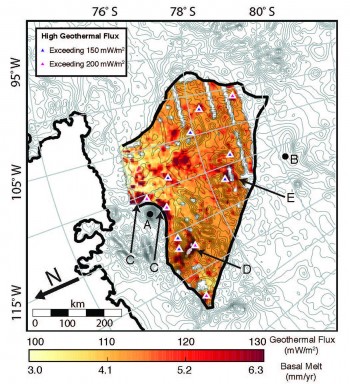Melting from Below
October 22, 2014

Thwaites Glacier, the large, rapidly changing outlet of the West Antarctic Ice Sheet, is not only being eroded by the ocean, but it is also being melted from below by geothermal heat, researchers at the University of Texas at Austin’s Institute for Geophysics (UTIG) report in the June 24, 2014, edition of the Proceedings of the National Academy of Sciences.
The findings significantly change the understanding of conditions beneath the West Antarctic Ice Sheet, where accurate information has previously been unobtainable.
Using radar techniques to map how water flows under ice sheets, UTIG researchers were able to estimate ice melting rates and thus identify significant sources of geothermal heat under Thwaites Glacier. They found these sources are distributed over a wider area and are much hotter than previously assumed.
The geothermal heat contributed significantly to melting of the underside of the glacier, possibly allowing the ice sheet to slide and affecting the ice sheet’s stability and its contribution to future sea level rise. The collapse of the Thwaites Glacier would cause a global sea level increase of 1 to 2 meters.
Until now, scientists had been unable to measure the strength or location of heat flow under the glacier. Current ice sheet models have assumed heat flow under the glacier is uniform, like a pancake griddle with even heat distribution across the bottom of the ice.
The findings of lead author Dusty Schroeder and his colleagues show the glacier sits on something more like a multi-burner stovetop, with burners putting out heat at different levels at different locations.
According to Schroeder’s findings, the minimum average geothermal heat flow beneath Thwaites Glacier is about 100 milliwatts per square meter (mW/m2), with hot spots over 200 mW/m2. For comparison, the average heat flow of the earth’s continents is less than 65 mW/m2.
The presence of water and heat present researchers with significant challenges. “The combination of variable subglacial geothermal heat flow and the interacting subglacial water system could threaten the stability of Thwaites Glacier in ways that we never before imagined,” Schroeder said.
Back to the Newsletter